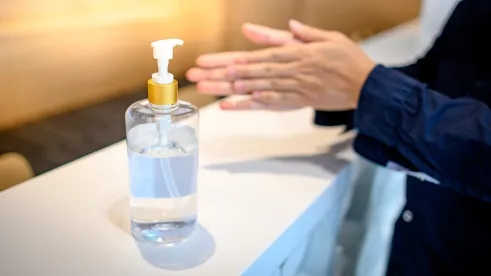The “Show Me” state largely sheltered in place on April 6, 2020, when Governor Michael L. Parson and the Missouri Department of Health and Senior Services (DHSS) issued their initial “Stay Home Missouri” order. This came on the heels of Governor Parson’s March 13 Executive Order 20-02 declaring a state of emergency and followed other Missouri counties’ and cities’ own stay-at-home declarations. The “Stay Home Missouri” order was then extended from April 24 through May 3, 2020.
Despite leaving open essential businesses, the effects of the COVID-19 crisis on Missouri employers and employees cannot be understated. As just one indicator, between the weeks ending March 21 and May 2, 2020, more than 500,000 people in Missouri filed for unemployment benefits. To put that number into perspective, the Missouri Division of Employment Security reported a total of 183,823 filers for all of fiscal year 2019, a nearly 2,500% increase in claims per day. Thus, for many citizens, safely reopening the state has become a primary concern.
On April 24, 2020, Governor Parson announced he was extending the state of emergency until June 15. However, at the same time, the governor announced the state would begin a reopening phase on May 4, 2020. In his press release, the governor stated, “I want to be clear that this is not an extension of the ‘Stay Home Missouri’ Order. Our order reopening Missouri will still take effect on Monday, May 4.” On April 27, 2020, the governor and DHSS released the details of Missouri’s “Show Me Strong Recovery Plan,” which includes:
- “Expand[ing] testing capacity and volume in the state”;
- “Expand[ing] reserves of PPE [personal protective equipment] by opening public and private supply chains”;
- “Continu[ing] to monitor and, if necessary, expand[ing] hospital and health care system capacity, including isolation and alternate care facilities for those that cannot self-quarantine at home”; and
- “Improv[ing] ability to predict potential outbreaks using Missouri’s public health data.”
The governor’s office reiterated that only time will tell how far and how fast the state can progress in recovery.
Below are summaries of Missouri’s statewide recovery plan as well as local reopening plans in St. Louis, Kansas City, and Columbia.
Missouri’s Statewide Recovery Plan
On May 4, 2020, Governor Parson’s “Stay Home Missouri” order expired. In its place, the governor issued the “Show Me Strong Recovery Plan”, which is scheduled to remain in effect until May 31, 2020, at which point it will be reevaluated. The plan reopens a large portion of the state (barring nursing homes and the like) with strict social distancing guidelines that include practicing good hygiene practices, remaining at least six feet apart whenever possible, and staying home if sick. Its accompanying guidelines for businesses provide broad guidance for Missouri businesses reopening in the absence of the stay-at-home order:
- “Prepare to implement basic infection prevention measures informed by industry best practices, regarding:
- Protective equipment;
- Temperature checks;
- Testing, isolating, and contact tracing; and
- Sanitation, including disinfection of common and high-traffic areas (entrances, breakrooms, locations where there is high-frequency employee interaction with the public/customers).”
- “Modify physical workspaces to maximize social distancing.”
- “Minimize business travel.”
- “Develop an infectious disease preparedness and response plan, including policies and procedures for workforce contact tracing when an employee tests positive for COVID-19.”
- “Monitor workforce for indicative symptoms. Do not allow symptomatic people to physically return to work until cleared by a medical provider.”
- “Develop, implement, and communicate about workplace flexibilities and protections, including:
- Encouraging telework whenever possible and feasible with business operations;
- Returning to work in phases and/or split shifts, if possible;
- Limiting access to common areas where personnel are likely to congregate and interact; and
- Ensuring that sick leave policies are flexible and consistent with public health guidance.”
Essential businesses should keep operating and incorporate the guidelines above.
In addition to these general guidelines, the recovery plan provides special considerations for “[a]ny entity that employs individuals . . . engaged in retail sales to the public.” According to the order, retailers must limit the number of individuals in any particular retail location as follows:
- “Twenty-five (25) percent or less of the entity’s authorized fire or building code occupancy, as set by local authorities, for a retail location with square footage of less than [10,000] square feet.”
- “Ten (10) percent or less of the entity’s authorized fire or building code occupancy, as set by local authorities, for a retail location with … [10,000] square feet . . . or more.”
In the absence of, or instead of an authorized fire or building code occupancy limit to work with, retailers can use the following equations:
- If your building is less than 10,000 square feet, then divide the building’s square feet by 30 and multiply that by .25 to get the applicable maximum occupancy;
- If your building is 10,000 square feet or more, then divide the building’s square feet by 30 and multiply that by .10 to get the acceptable maximum occupancy.
In its frequently asked questions (FAQs), the state makes clear that grocery stores and similar entities are considered retailers, but that they are encouraged to only allow one shopper per household at any one time and to set aside times for third-party grocery delivery services in an effort to reduce congestion. According to the FAQs, restaurants and hotels do not qualify as retailers. Employees and vendors delivering goods to the store do not count toward the maximum occupancy limitations.
The recovery order also explicitly provides rules for restaurants that have decided to reopen for dine-in service. In addition to the general guidelines listed above, restaurants must:
- include “proper spacing of at least six feet (6’) between tables”;
- not engage in “communal seating areas to parties that are not connected”;
- have “no more than ten (10) people at a single table” and only if connected as a group; and
- continue the “use of drive-thru, pickup, or delivery options.”
As with previous orders, local and state health authorities and law enforcement oversee enforcement of the plan. Believing that local communities are best situated to determine their own rules, the recovery order makes clear that local authorities can add to the Missouri restrictions and keep their locales closed. Hence, a business could be in a locale that restricts its reopening despite the state’s recovery plan. Below is a discussion of the reopening plans of some of the major locales in Missouri, and how they differ, if at all, from the state’s plan.
St. Louis County
On May 8, 2020, the St. Louis County Department of Public Health revealed its own reopening order, entitled “Business and Individual Guidelines for Social Distancing and Re-Opening.” Effective May 18, 2020, the order “eases restrictions on individuals and businesses, including allowing businesses to resume operating or continue operations, so long as they do so in alignment with this order and with the intent to protect employees and patrons.” However, the order covering St. Louis County is clearly more detailed and restrictive than Missouri’s recovery order. Specifically, the St. Louis County order provides:
- “A person or business shall not organize or attend an intentional Gathering of more than 10 people in a single space or room, indoors or outdoors; [and] all Gatherings shall comply with Social Distancing Requirements and are encouraged to comply with Face Covering recommendations.”
- “All Businesses shall comply with Social Distancing Requirements and Disinfection Processes.”
- The order defines “Social Distancing Requirements” as “to the extent possible, maintaining at least a six-foot social distancing from other individuals; washing hands with soap and water for at least twenty seconds as frequently as possible or using hand sanitizer with more than sixty percent alcohol; covering coughs or sneezes with something other than hands; regularly cleaning high-touch surfaces; not shaking hands; and behaviors as otherwise defined by order.”
- The order also defines “Disinfection Process” to include (a) “providing hand washing or sanitizing opportunities for the public where possible”; and (b) “requiring frequent sanitation of high touch areas with products thought to destroy COVID-19.”
- The order specifies that high touch areas “include, but are not limited to: [h]andrails; [e]levator buttons; [d]oor handles; [c]heck-out areas, including keypads, credit card machines and any other such systems; [c]arts and baskets; [r]estrooms; and [s]hared computers or kiosks.”
- “All Businesses shall require frequent Disinfection Processes for all high touch surfaces and any other areas that may be frequently touched by customers, employees, volunteers or any other individuals.”
- “All Businesses shall provide reasonable breaks for employees and volunteers to wash hands.”
- “All Businesses shall train employees about procedures related to Disinfection Processes and Social Distancing Requirements.”
- “All Businesses shall provide employees and volunteers working in the Businesses’ facility with Face Coverings or supplies to make Face Coverings.”
- “All Businesses shall require employees or volunteers to wear Face Coverings while at work, unless such employee or volunteer is working alone in an enclosed area or has a medical reason not to wear a Face Covering.”
- “All Businesses shall conduct daily screenings of employees and volunteers who work in their facilities for symptoms of COVID-19.”
- “All Businesses shall encourage employees or volunteers to quarantine or isolate if they have or are believed to have COVID-19 or if they have come into contact with individual(s) with COVID-19.”
The St. Louis County order also provides specific rules for businesses that “engage in direct interactions with members of the public, and primarily provide goods for sale, food or drink for consumption, personal services requiring sustained in-person contact, or religious or spiritual services.” These businesses must:
- “Limit the number of individuals in any particular location to 25 (twenty-five) percent or less of the entity’s authorized fire or building code occupancy in facilities with square footage of less than ten thousand square feet (10,000 ft2); or ten (10) percent or less of the entity’s authorized fire or building code occupancy in facilities with square footage of ten thousand square feet (10,000 ft2) or more.”
- “Install physical barriers between customers and employees where possible or otherwise ensure six (6) feet of distance between customers and employees, particularly in check-out lines, return-lines or any other place where there is prolonged contact between the customer and employee.”
- “[I]nstall clear markings with signage, tape, or other means to show six (6) feet of distance” in all areas that are prone to lines or congregation.
- “Provide signage inside and outside the facility outlining Social Distancing Requirements, limitations on crowd size, and procedures to limit crowd size.”
- “Prohibit customers from bringing outside containers, including reusable bags or boxes, into the facility.”
- Establish special hours of operation, wherever possible, for individuals who are at “high risk” for COVID-19 as defined by the U.S. Centers for Disease Control and Prevention (CDC).
- “Arrange for contactless payment, pick-up and delivery options whenever feasible and provide postings as to the availability of such services.”
The St. Louis County order explicitly empowers businesses to “deny entry to members of the public who refuse to wear Face Coverings for non-medical reasons,” while also prohibiting businesses from requiring “documentation verifying a medical condition” or asking “about the nature of the medical condition.” The order also prohibits entertainment; conference and sporting venues; gyms and fitness centers; banquet rooms; bars and businesses that primarily serve alcohol and do not serve full meals, other than curbside; indoor and outdoor public pools; sporting events; sports courts; and playgrounds from reopening, “except with respect to the minimum necessary activities to maintain the value of a business’s inventory, provide security, process payroll or employee benefits,” or to facilitate remote work.
It is unclear how long the St. Louis County order will remain in effect. Violations of the order may lead to an appealable closure of the business. The order will be enforced by the local health department and law enforcement authorities. Additional guidance for specific business-types can be found on the St. Louis County website.
City of St. Louis
On May 8, 2020, St. Louis City Mayor Lyda Krewson outlined similar plans for reopening the City of St. Louis. While the city’s plan largely mirrors the county’s plan, there are some key differences:
- Businesses are not required to take the following actions, but are instructed to “consider”:
- “installing physical barriers between customers and employees”;
- “using tape or other means to increase compliance with social distancing recommendations”;
- “providing separate operating hours for vulnerable populations”; and
- adopting “other techniques to increase social distancing such as staggered shifts.”
The City of St. Louis’ plan also allows all bars to reopen on May 18, whereas the county order limits such businesses to curbside and pickup service. It is unclear how long the city’s plan will remain in effect. Additional guidance for specific business-types can be found on the City of St. Louis website.
Kansas City
On April 29, 2020, Kansas City Mayor Quinton Lucas announced plans for the city’s phased reopening. Effective May 15, 2020, “all Kansas City businesses will be able to open, subject to a ‘10/10/10 [r]ule.’” Mayor Lucas also issued his “Sixth Amended Order 20-01,” which provides additional guidance for Kansas City employers.
Under the new emergency order, public-facing (i.e., generally open and serving the public) non-essential businesses may resume in-person operations provided they follow the 10/10/10 rule, including:
- Allow no more than 10 customers or 10 percent of building occupancy, whichever is greater;
- Maintain, for a minimum of 30 days, a record of individuals who have been on the premises for more than 10 minutes, to only be used for public health purposes (g., tracing in case of an outbreak); and
- Adhere to social distancing guidelines, but to the extent these rules cannot be followed, use facial coverings, gloves, and any other equipment mandated by local, state, and/or CDC guidelines.
Non-essential businesses that are not open to the public “can resume in-person and delivery operations, provided they operate in accordance with guidance provided by the Health Department and allow workers to maintain social distancing.”
According to the order, Kansas City “strongly encourages all employers to continue to allow individuals to work from home to the extent feasible, and to make accommodations for individuals at high risk for serious complications from COVID-19.”
Jackson County
On May 15, 2020, phase one of the Jackson County reopening plan officially commenced, continuing use of the 10/10/10 for all businesses. Effective May 10, 2020, all businesses are required to prepare and post (visible to customers and employees) a “Social Distancing Protocol” for each facility in the county frequented by the public or employees.
In addition, the plan states that employers are required to post two safety signs at their workplaces: a customer safety sign at the public entrance of the organization and a worker safety sign at the employee entrance(s). “If there is only one entrance,” the plan clarifies, “both signs can be displayed at that entrance.” Employers are also encouraged, if applicable, to “screen workers for fevers and any symptoms of COVID with a questionnaire at workplace entrance daily.”
Employers should note that the Jackson County Health Department is not able “to ‘sign off’ on the ways individual businesses implement” the reopening guidelines. Employers may obtain information by contacting the Jackson County Health Department call center (816-404-9883) or by identifying COVID-19 coordinators within their organizations who can sign up for an email distribution list. The listserv will send out emails from the Jackson County Health Department with practical strategies for employers and real-time updates, including “mid-phase changes made to prevent relapse or promote the ability of the community to advance to the next phase.”
This Kansas City order was scheduled to be reevaluated on May 15, 2020.
City of Columbia and Boone County
The City of Columbia and Boone County issued a joint guide for reopening in May. This 50-page guide is extensive and covers general business requirements as well as specific rules and guidance for businesses of varying types such as retailers, including jewelry stores, luggage stores, and car dealerships; restaurants; grocery stores; personal care facilities; entertainment facilities, including mini-golf and axe throwing; and gyms and fitness centers. The guide also instructs on how to facilitate funerals and weddings. Some key differences between the City of Columbia guidance and those issued in other locales are as follows:
- Restaurants can open, but must get an inspection first.
- Businesses must appoint an employee to oversee their disinfection plans.
- Cash registers must be spaced six feet apart.
- Fitting rooms must remain closed.
- Curbside orders must be packaged, processed, and paid for ahead of time.
- Bars may not reopen.
- Grocery stores may not allow “sampling or tasting of any food items.”
- Personal care businesses must keep a log of customers’ contact information.
This joint guide, which is the most detailed of the reopening plans, does not specify an end date. Employers may want to review this guide for best practices, even if they are operating a business in a more relaxed locale.
It should be noted that many other Missouri counties are under local orders largely identical to Missouri’s statewide recovery plan. Specific details of these orders can be found on the DHSS website.
Conclusion
Missouri’s reopening plan takes a measured approach by generally reopening the state while allowing local communities to decide to implement additional restrictions and to develop their own reopening plans. Given the varying approaches adopted in certain communities within the state, employers may want to be careful to review their local city, county, and state requirements prior to reopening.







 />i
/>i

